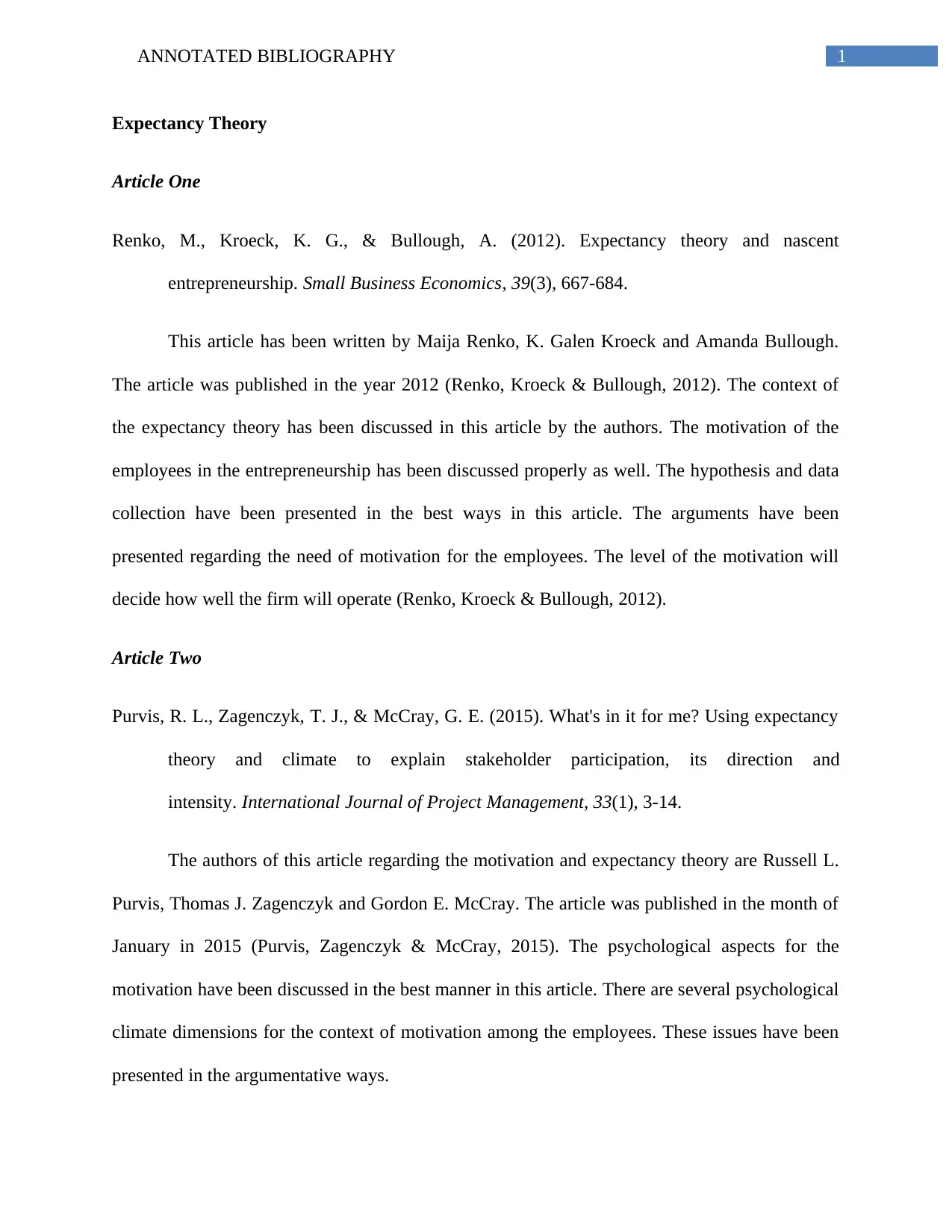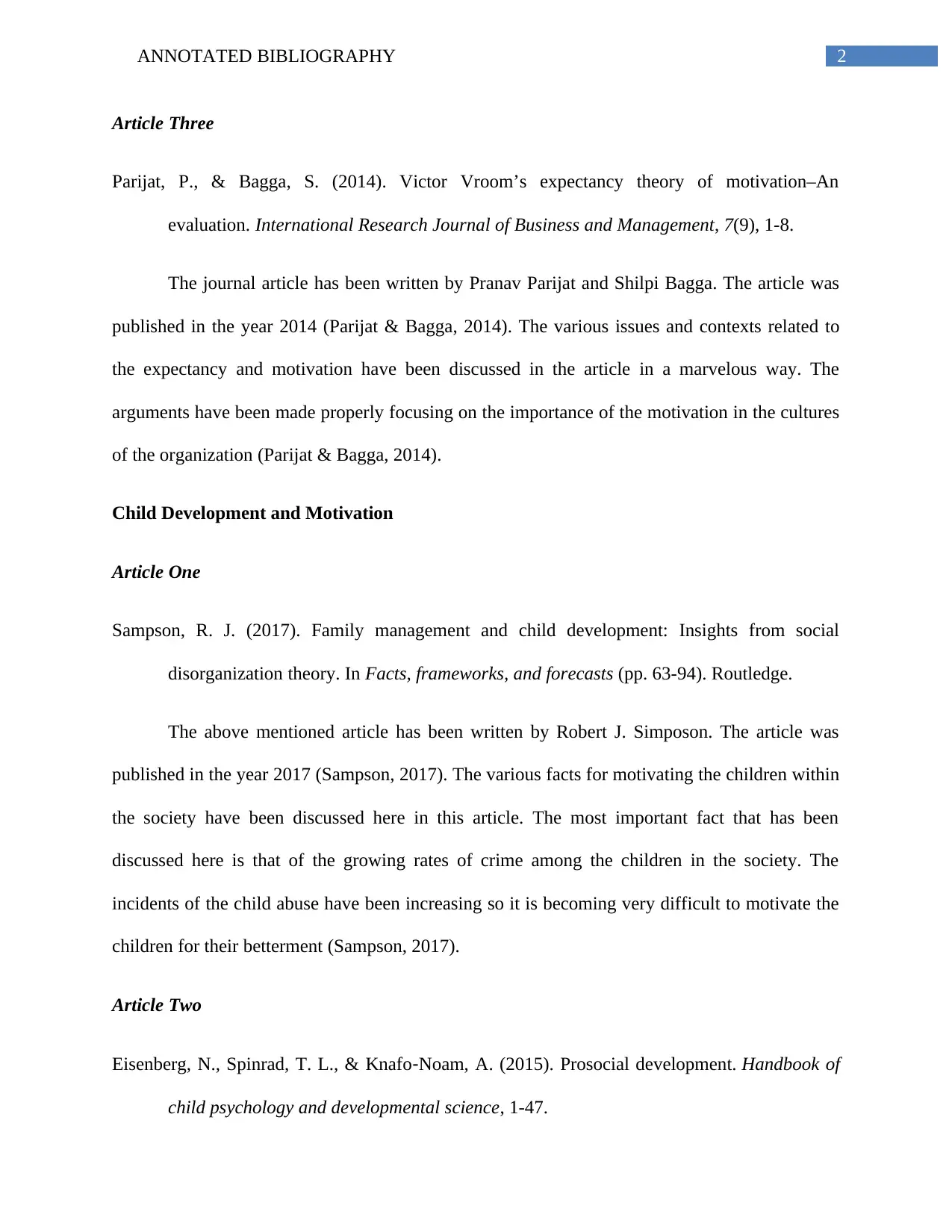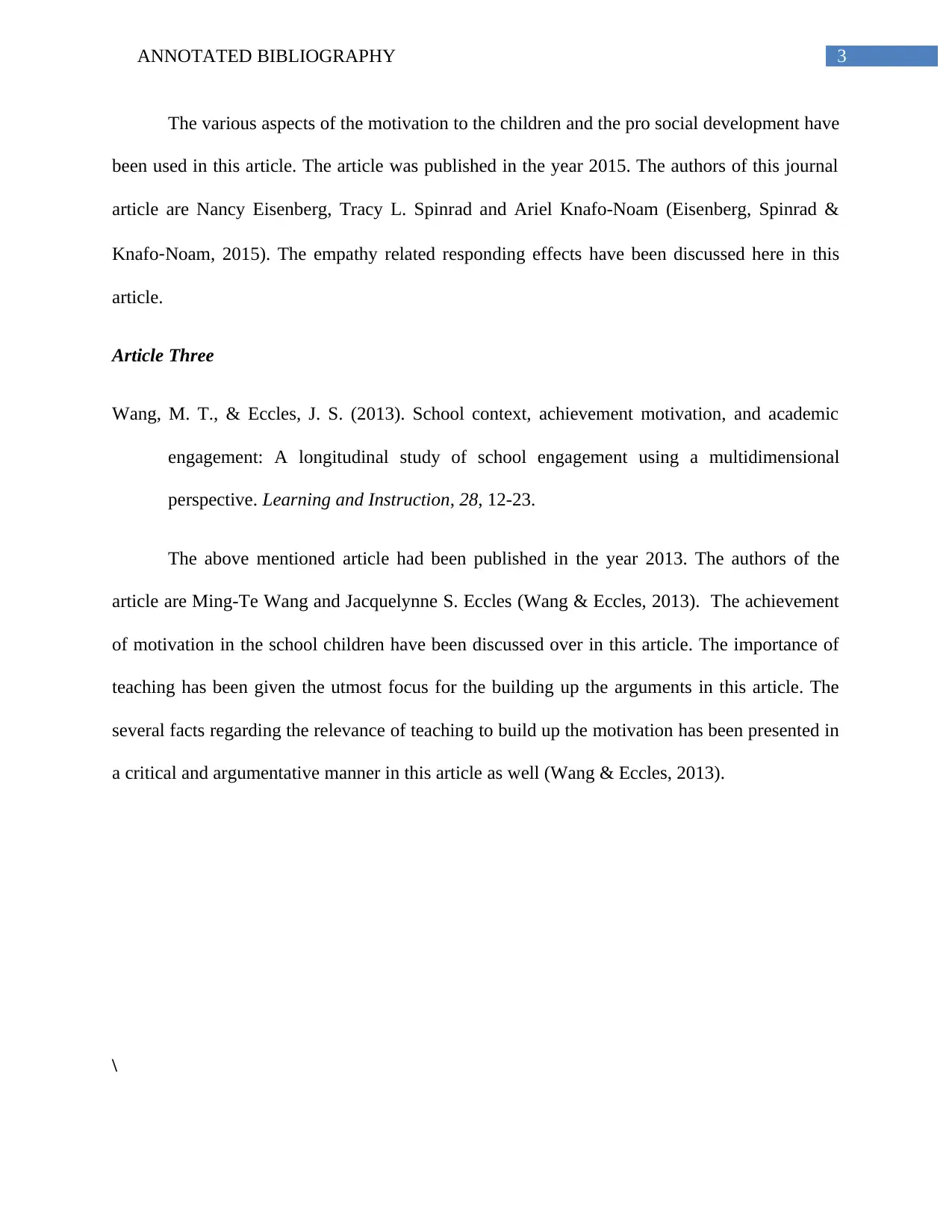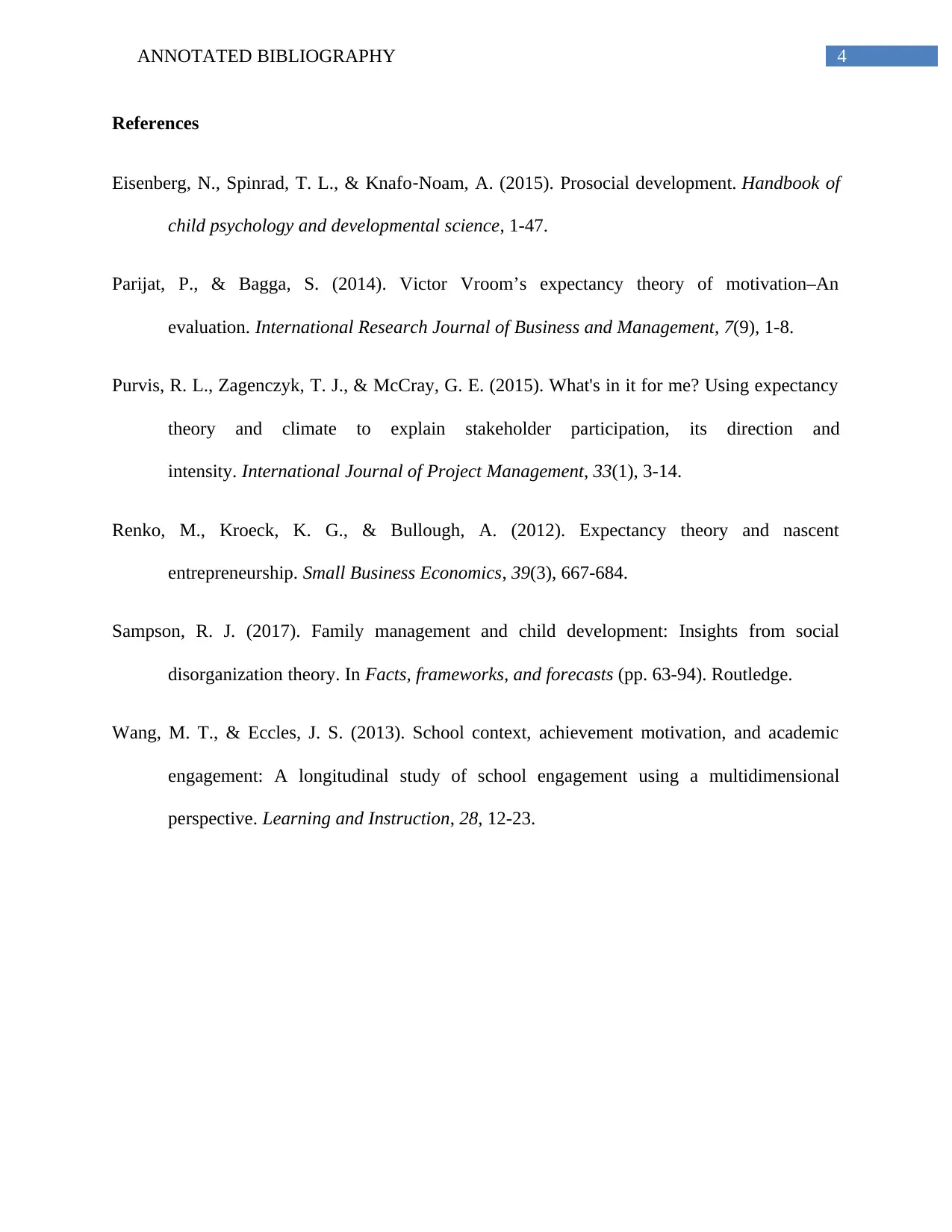Annotated Bibliography: Motivation and Expectancy Theory
VerifiedAdded on 2023/05/29
|5
|1072
|443
Annotated Bibliography
AI Summary
This annotated bibliography presents a critical review of research articles related to motivation, expectancy theory, and child development. The bibliography includes summaries and analyses of articles focusing on employee motivation in entrepreneurship, the psychological aspects of motivation, and the application of expectancy theory. Additionally, it explores articles examining child development, including factors influencing motivation, prosocial behavior, and academic engagement within school contexts. Each entry provides a concise overview of the article's content, methodology, and key arguments, offering insights into the multifaceted nature of motivation across different domains. The bibliography is a valuable resource for understanding current research and its implications.

Running head: ANNOTATED BIBLIOGRAPHY
Annotated Bibliography
Name of the Student
Name of the University
Author Note
Annotated Bibliography
Name of the Student
Name of the University
Author Note
Paraphrase This Document
Need a fresh take? Get an instant paraphrase of this document with our AI Paraphraser

1ANNOTATED BIBLIOGRAPHY
Expectancy Theory
Article One
Renko, M., Kroeck, K. G., & Bullough, A. (2012). Expectancy theory and nascent
entrepreneurship. Small Business Economics, 39(3), 667-684.
This article has been written by Maija Renko, K. Galen Kroeck and Amanda Bullough.
The article was published in the year 2012 (Renko, Kroeck & Bullough, 2012). The context of
the expectancy theory has been discussed in this article by the authors. The motivation of the
employees in the entrepreneurship has been discussed properly as well. The hypothesis and data
collection have been presented in the best ways in this article. The arguments have been
presented regarding the need of motivation for the employees. The level of the motivation will
decide how well the firm will operate (Renko, Kroeck & Bullough, 2012).
Article Two
Purvis, R. L., Zagenczyk, T. J., & McCray, G. E. (2015). What's in it for me? Using expectancy
theory and climate to explain stakeholder participation, its direction and
intensity. International Journal of Project Management, 33(1), 3-14.
The authors of this article regarding the motivation and expectancy theory are Russell L.
Purvis, Thomas J. Zagenczyk and Gordon E. McCray. The article was published in the month of
January in 2015 (Purvis, Zagenczyk & McCray, 2015). The psychological aspects for the
motivation have been discussed in the best manner in this article. There are several psychological
climate dimensions for the context of motivation among the employees. These issues have been
presented in the argumentative ways.
Expectancy Theory
Article One
Renko, M., Kroeck, K. G., & Bullough, A. (2012). Expectancy theory and nascent
entrepreneurship. Small Business Economics, 39(3), 667-684.
This article has been written by Maija Renko, K. Galen Kroeck and Amanda Bullough.
The article was published in the year 2012 (Renko, Kroeck & Bullough, 2012). The context of
the expectancy theory has been discussed in this article by the authors. The motivation of the
employees in the entrepreneurship has been discussed properly as well. The hypothesis and data
collection have been presented in the best ways in this article. The arguments have been
presented regarding the need of motivation for the employees. The level of the motivation will
decide how well the firm will operate (Renko, Kroeck & Bullough, 2012).
Article Two
Purvis, R. L., Zagenczyk, T. J., & McCray, G. E. (2015). What's in it for me? Using expectancy
theory and climate to explain stakeholder participation, its direction and
intensity. International Journal of Project Management, 33(1), 3-14.
The authors of this article regarding the motivation and expectancy theory are Russell L.
Purvis, Thomas J. Zagenczyk and Gordon E. McCray. The article was published in the month of
January in 2015 (Purvis, Zagenczyk & McCray, 2015). The psychological aspects for the
motivation have been discussed in the best manner in this article. There are several psychological
climate dimensions for the context of motivation among the employees. These issues have been
presented in the argumentative ways.

2ANNOTATED BIBLIOGRAPHY
Article Three
Parijat, P., & Bagga, S. (2014). Victor Vroom’s expectancy theory of motivation–An
evaluation. International Research Journal of Business and Management, 7(9), 1-8.
The journal article has been written by Pranav Parijat and Shilpi Bagga. The article was
published in the year 2014 (Parijat & Bagga, 2014). The various issues and contexts related to
the expectancy and motivation have been discussed in the article in a marvelous way. The
arguments have been made properly focusing on the importance of the motivation in the cultures
of the organization (Parijat & Bagga, 2014).
Child Development and Motivation
Article One
Sampson, R. J. (2017). Family management and child development: Insights from social
disorganization theory. In Facts, frameworks, and forecasts (pp. 63-94). Routledge.
The above mentioned article has been written by Robert J. Simposon. The article was
published in the year 2017 (Sampson, 2017). The various facts for motivating the children within
the society have been discussed here in this article. The most important fact that has been
discussed here is that of the growing rates of crime among the children in the society. The
incidents of the child abuse have been increasing so it is becoming very difficult to motivate the
children for their betterment (Sampson, 2017).
Article Two
Eisenberg, N., Spinrad, T. L., & Knafo‐Noam, A. (2015). Prosocial development. Handbook of
child psychology and developmental science, 1-47.
Article Three
Parijat, P., & Bagga, S. (2014). Victor Vroom’s expectancy theory of motivation–An
evaluation. International Research Journal of Business and Management, 7(9), 1-8.
The journal article has been written by Pranav Parijat and Shilpi Bagga. The article was
published in the year 2014 (Parijat & Bagga, 2014). The various issues and contexts related to
the expectancy and motivation have been discussed in the article in a marvelous way. The
arguments have been made properly focusing on the importance of the motivation in the cultures
of the organization (Parijat & Bagga, 2014).
Child Development and Motivation
Article One
Sampson, R. J. (2017). Family management and child development: Insights from social
disorganization theory. In Facts, frameworks, and forecasts (pp. 63-94). Routledge.
The above mentioned article has been written by Robert J. Simposon. The article was
published in the year 2017 (Sampson, 2017). The various facts for motivating the children within
the society have been discussed here in this article. The most important fact that has been
discussed here is that of the growing rates of crime among the children in the society. The
incidents of the child abuse have been increasing so it is becoming very difficult to motivate the
children for their betterment (Sampson, 2017).
Article Two
Eisenberg, N., Spinrad, T. L., & Knafo‐Noam, A. (2015). Prosocial development. Handbook of
child psychology and developmental science, 1-47.
⊘ This is a preview!⊘
Do you want full access?
Subscribe today to unlock all pages.

Trusted by 1+ million students worldwide

3ANNOTATED BIBLIOGRAPHY
The various aspects of the motivation to the children and the pro social development have
been used in this article. The article was published in the year 2015. The authors of this journal
article are Nancy Eisenberg, Tracy L. Spinrad and Ariel Knafo-Noam (Eisenberg, Spinrad &
Knafo‐Noam, 2015). The empathy related responding effects have been discussed here in this
article.
Article Three
Wang, M. T., & Eccles, J. S. (2013). School context, achievement motivation, and academic
engagement: A longitudinal study of school engagement using a multidimensional
perspective. Learning and Instruction, 28, 12-23.
The above mentioned article had been published in the year 2013. The authors of the
article are Ming-Te Wang and Jacquelynne S. Eccles (Wang & Eccles, 2013). The achievement
of motivation in the school children have been discussed over in this article. The importance of
teaching has been given the utmost focus for the building up the arguments in this article. The
several facts regarding the relevance of teaching to build up the motivation has been presented in
a critical and argumentative manner in this article as well (Wang & Eccles, 2013).
\
The various aspects of the motivation to the children and the pro social development have
been used in this article. The article was published in the year 2015. The authors of this journal
article are Nancy Eisenberg, Tracy L. Spinrad and Ariel Knafo-Noam (Eisenberg, Spinrad &
Knafo‐Noam, 2015). The empathy related responding effects have been discussed here in this
article.
Article Three
Wang, M. T., & Eccles, J. S. (2013). School context, achievement motivation, and academic
engagement: A longitudinal study of school engagement using a multidimensional
perspective. Learning and Instruction, 28, 12-23.
The above mentioned article had been published in the year 2013. The authors of the
article are Ming-Te Wang and Jacquelynne S. Eccles (Wang & Eccles, 2013). The achievement
of motivation in the school children have been discussed over in this article. The importance of
teaching has been given the utmost focus for the building up the arguments in this article. The
several facts regarding the relevance of teaching to build up the motivation has been presented in
a critical and argumentative manner in this article as well (Wang & Eccles, 2013).
\
Paraphrase This Document
Need a fresh take? Get an instant paraphrase of this document with our AI Paraphraser

4ANNOTATED BIBLIOGRAPHY
References
Eisenberg, N., Spinrad, T. L., & Knafo‐Noam, A. (2015). Prosocial development. Handbook of
child psychology and developmental science, 1-47.
Parijat, P., & Bagga, S. (2014). Victor Vroom’s expectancy theory of motivation–An
evaluation. International Research Journal of Business and Management, 7(9), 1-8.
Purvis, R. L., Zagenczyk, T. J., & McCray, G. E. (2015). What's in it for me? Using expectancy
theory and climate to explain stakeholder participation, its direction and
intensity. International Journal of Project Management, 33(1), 3-14.
Renko, M., Kroeck, K. G., & Bullough, A. (2012). Expectancy theory and nascent
entrepreneurship. Small Business Economics, 39(3), 667-684.
Sampson, R. J. (2017). Family management and child development: Insights from social
disorganization theory. In Facts, frameworks, and forecasts (pp. 63-94). Routledge.
Wang, M. T., & Eccles, J. S. (2013). School context, achievement motivation, and academic
engagement: A longitudinal study of school engagement using a multidimensional
perspective. Learning and Instruction, 28, 12-23.
References
Eisenberg, N., Spinrad, T. L., & Knafo‐Noam, A. (2015). Prosocial development. Handbook of
child psychology and developmental science, 1-47.
Parijat, P., & Bagga, S. (2014). Victor Vroom’s expectancy theory of motivation–An
evaluation. International Research Journal of Business and Management, 7(9), 1-8.
Purvis, R. L., Zagenczyk, T. J., & McCray, G. E. (2015). What's in it for me? Using expectancy
theory and climate to explain stakeholder participation, its direction and
intensity. International Journal of Project Management, 33(1), 3-14.
Renko, M., Kroeck, K. G., & Bullough, A. (2012). Expectancy theory and nascent
entrepreneurship. Small Business Economics, 39(3), 667-684.
Sampson, R. J. (2017). Family management and child development: Insights from social
disorganization theory. In Facts, frameworks, and forecasts (pp. 63-94). Routledge.
Wang, M. T., & Eccles, J. S. (2013). School context, achievement motivation, and academic
engagement: A longitudinal study of school engagement using a multidimensional
perspective. Learning and Instruction, 28, 12-23.
1 out of 5
Your All-in-One AI-Powered Toolkit for Academic Success.
+13062052269
info@desklib.com
Available 24*7 on WhatsApp / Email
![[object Object]](/_next/static/media/star-bottom.7253800d.svg)
Unlock your academic potential
Copyright © 2020–2025 A2Z Services. All Rights Reserved. Developed and managed by ZUCOL.
